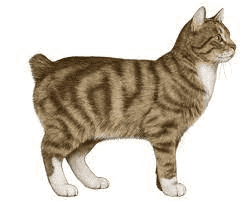Manx syndrome encompasses a number of issues involving the function of the hind legs, urinary bladder, and colon of a tailless cat. In affected cats, the spine and spinal cord are shortened because the last few vertebrae and spinal segments have not developed normally, which can occur as an ‘accident’ when breeding for a very short tail.

which can affect other bony structures too
Inheritance
Manx syndrome is most common in Manx cats; however, it has been occasionally described in some other breeds of cats that have shortened tails or are tail-less. This British breed from the Isle of Man is typically tailless.
Manx syndrome is an inherited in the Manx cat, but the degree of spinal malformation can vary. All Manx cats, with or without a tail, have the mutated gene and can produce offspring that are tail-less. Neurological problems are most common in tail-less cats.
Signs
Some tailless cats have mild or no neurologic changes, while others have severe neurologic problems.
The degree of severity depends on how severely the cat’s spinal cord is affected. Significantly affected cats may die before being born or because of significant problems, be euthanized soon after birth.
Typically, signs are noted when the kitten starts to walk. Clinical signs may include a type of hopping gait, where the cat walks like a rabbit hopping. Urinary and fecal incontinence, lack of sensation in the hind legs and around the openings of the anus and urethra, and some level of hind end paralysis may also be seen.
Those cats whose hind legs do not function the way they should have trouble participating in typical cat behaviors, such as jumping and running and climbing and need to be kept as indoor cats
Signs can include:
- Being tail-less
- Urinary or fecal incontinence
- Secondary urinary tract infections
- Urinary scalding and staining
- Constipation
- Partial paralysis of the hind legs, which can cause difficulty walking
- Bunny hopping movements when walking about
- Lack of sensation of the skin around the anal/perineal area
- Stance in which the cat walks on their entire foot instead of the toes
- Rectal prolapse
- Some cats may develop an issue where the colon stretches from fecal buildup as the colon doesn’t move normally and the cat can’t defecate properly so stool builds up and gradually dilates the colon. This is called “megacolon.” Chronic constipation is the main issue.
Diagnostics and Treatment
Your veterinarian will take a thorough medical history and perform a complete physical examination to make the diagnosis. Some radiographs or other imaging tests may be recommended, as well as a urinalysis, a neurologic examination, and a bacterial culture to test for a urinary tract infection.
There is no curative treatment. All that can be offered is supportive care and keeping the cat clean while managing any incontinence, hygiene, megacolon, urinary tract infections, and constipation.
Daily grooming is necessary for cats incapable of controlling their bowels or bladder as chronic skin contact with urine or feces can start an ongoing struggle with lifelong skin irritation and urinary infections that must be treated.
If your cat is incontinent, your veterinarian can show you how to manually empty the bladder to help prevent urine scald and bladder infection.
Diapers can be used to prevent soiling if your cat will tolerate them but the surrounding area needs to be cleaned regularly or diaper rash will become a significant problem. Stool softeners, canned food and medications to try and improve colon motility can help ease constipation.
Prevention
Parents of affected cats should not be bred again to prevent suffering. If you are thinking of purchasing a Manx cat, it is best to research the genetic line of a kitten your are thinking about to ensure no affected cats have been used for breeding.


